Local SEO: The Ultimate Guide To Ranking Your Local Business
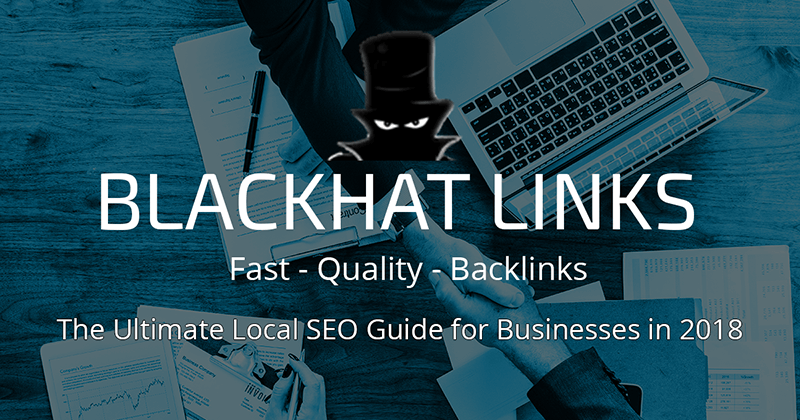
Local SEO – The Ultimate Guide for Ranking Your Local Business
Are you a local business owner looking to attract more local customers? Or maybe an SEO expert in charge of a Local campaign for a small business? If so, look no further! We at Blackhatlinks.com have decided to create a thorough local SEO guide for local business owners and marketers alike, guaranteed to put your business in the map and start passively boosting your income in the form of customers and leads.
You might be wondering: how can your business benefit from local SEO?
- For starters, it’s been determined that almost 72% of consumers actively read online reviews and testimonials before they buy a product.
- Users that search and find localized results were more likely to become customers. Customers found it more convenient to shop or acquire services from businesses near them.
- Local SEO (along with purchasing PBN backlinks), has the highest return on investment in the online marketing world because it targets very high-quality traffic.
With a few easy steps, you can quickly position your business at the top of the local rankings, especially given the effective and easy to implement nature of Local SEO marketing.
In this local SEO guide we’ll talk about a variety of factors: from how your domain should be, to what schemas you should use to structure your data and even how your social media profile and website should look like.
Let’s begin!
Local SEO Guide: Optimizing for Google First

To truly make the most of this local SEO guide it’s important we understand Google’s role, position, and importance in local business rankings:
Google is all about finding valuable answers to user queries and searches. With a staggering 70-90% of search market share (depending on the source and device), it goes without saying that we’ll leverage Google’s tools, and algorithm variables to fully optimize your local SEO marketing efforts.
The good news is that Google has evolved its technology and algorithm to give local businesses a considerable competitive edge for keywords regularly used by local searchers. To that end, we’ll deeply discuss and optimize your business Google + and Google My Business pack in our local SEO guide.
Before getting into that, let’s talk about some basic requirements your website needs to cover.
Local SEO Marketing: Choosing a Domain
One of the foundations of effective local SEO marketing is helping Google understand where you’re located, and what kind of customer queries you’re looking to rank for.
If you’re starting a new website, it’s recommended that you use a ccTLD similar to the one used by Google in your country. A ccTLd is a country code top-level domain, and it serves as a “country code” that helps search engines determine where your business is located.
For example, if Google uses google.com.au then you should use yourwebsite.com.au instead of yourwebsite.au
An alternative method is to geotag your website’s location via Google Webmaster Tool .You can do it by accessing your site’s settings, clicking on search traffic, international targeting and selecting your country on the list.
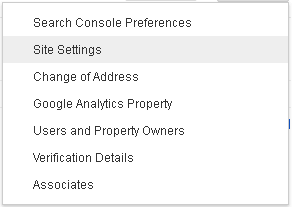
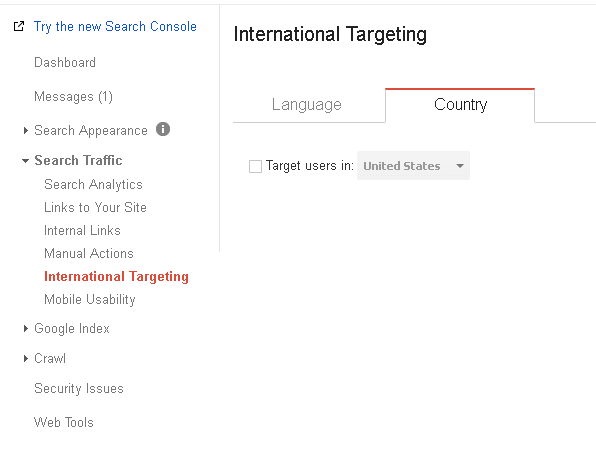
Nonetheless, keep in mind that if you have, for example, a Swedish domain (yourbusiness.se) you won’t be able to geotag your site for an Australian audience (yourbusiness.com.au) with Google’s webmaster settings.
Local SEO and Mobile Responsive Websites

A few years ago it was predicted that mobile users would eventually overtake desktop users on the internet. And they were right. This is why mobile responsiveness is a must in our local SEO guide.
Smartphones are more popular than ever, and those who invested in mobile responsive websites have seen their revenue and customer retention skyrocket. The exact portion of mobile users a website can have largely depends on the industry or commercial sector the business operates in, but whether it’s 40% or 72%, it represents a very large chunk of customers you can’t afford to miss.
Google had already decided back in 2015 to boost mobile responsive websites, effectively penalizing in the ranks those that didn’t. Remember, Google’s ultimate goal is to present its users with high-quality answers to their queries. If they find that your users are having trouble reading your content on their tablet or smartphone, they will bury you in the SERPS.
Investing in a redesign that focuses on mobile responsiveness is a wise investment. There are many options themes and options in WordPress websites that effectively make your website more appealing, modern and easy to navigate on all devices, and if you’re not familiar with it, you can always hire a professional to do this for you.
Local SEO Guide: Google My Business for local rankings
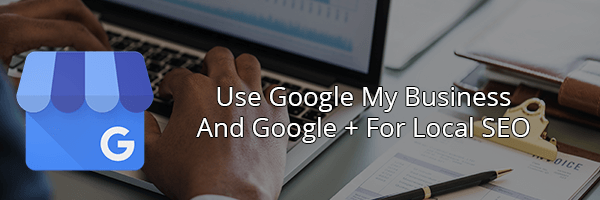
Google My Business is a free service provided by Google to help businesses rank locally. Registering your own Google My Business page is hands down, a critical step in this local SEO guide.
Simply enter the Google My Business website and enter the business-related data that they require. This will allow your business to opt-in for prioritized results in Google’s Local Pack.
It’s very important that your NAP+W information is completely streamlined at this point. NAP+W stands for your business’ Name, Address, Phone + Website, and it’s the cornerstone to getting more citations (which improve your local rankings). The idea is to use this exact same information in other directories, such as the Better Business Bureau, Yellow Pages or Yelp and help search engines improve your rankings and exposure over time.
Local SEO Guide: Google + for local rankings
Often people are confused as to what Google Plus and Google My Business are and how they interact with each other when ranking businesses.
Think of Google My business as your dashboard for managing your Google Properties (Google Analytics, Google Plus, Adwords Express, etc). Keep in mind that if you have multiple stores scattered along different states or countries, you’ll need to follow this process for each of these locations. While somewhat tedious, the time invested is well worth it.
Google Plus will also help you establish yourself as an authority in your industry since you can leverage Google Posts as well as testimonials and reviews your target is likely to read (more on this later!).
Overall Google has streamlined a lot of their tools, we used to have Google Places instead of Google My Business and configuring your Google Plus page a few years ago was considerably more complicated. Thanks to Google My Business dashboard design you can easily manage a big part of your local SEO marketing efforts.
Now that you have your NAP+W and Google Local Pack set up, you need to start looking at your Keyword Research and other SEO factors.
Local SEO Guide: Keyword Research
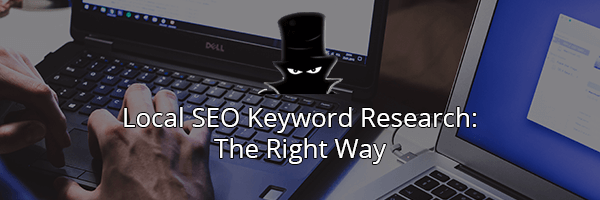
Our local SEO guide couldn’t be complete without mentioning local keyword research.
Keywords are the bridge between your target audience and your business. You need to understand their needs, topics they find interesting and of course how these translate into solutions in the form of your products and services.
There are some basic guidelines, but if you’re not entirely sure how to conduct proper keyword research, it’s not a bad idea to outsource this service to an agency. It’s a critical step that is best left to professionals. If you’re set on doing this yourself, then please dedicate enough time to this task. Don’t rush it!
Let’s say you own a law firm in Florida. Your first impulse would probably be to target the keyword “lawyers Florida”, and if you go by volume alone you could be correct, but we’re not going for sheer volume, we need effective traffic. To that end, you might instead want to try, “criminal lawyers + city/county”.
Laws vary from state to state, and some licenses are only valid in certain counties. So, in this case, an even more localized keyword combination would yield better results. Notice that we’re going for customers with the intention to convert and not search volume alone.
There are many tools that you can use for finding highly profitable local keywords for your business, but you can start with Google’s Keyword Planner. Just use the following settings:
- Sign in to your Google Account, and enter your Keyword Planner tab
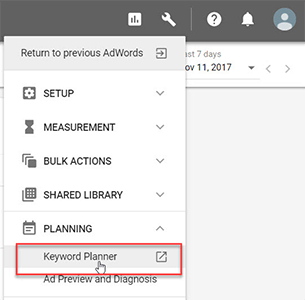
- If you get the new Keyword Planner (still in testing as of today), click on the “Open Previous Keyword Planner” option below
![]()
- Click on “Find new keywords and get search volume data”
![]()
- Enter a “seed word” under product/service, which serves as a broad term that describes your services or products.
- Under location, select your country.
- In the “Keywords to include” tab, enter your county or state.
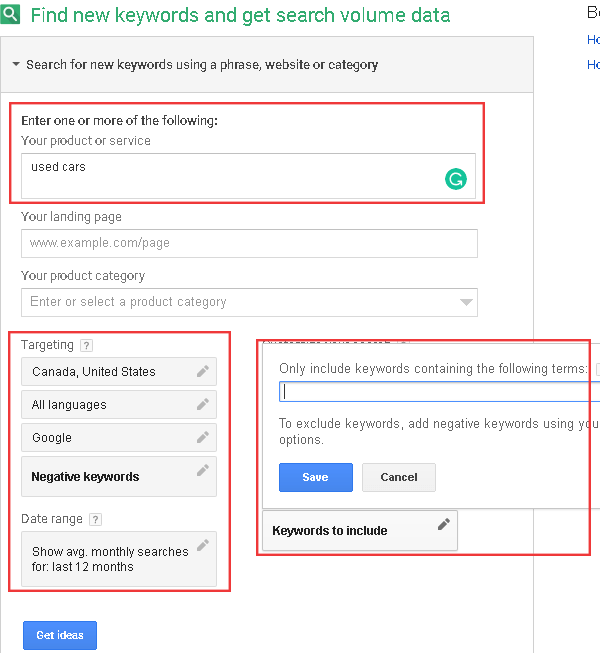
With these settings, you’ll get a decent set of possible keywords you could go after. Go ahead and look at the list of suggestions Google came up with. Check for their volumes, and try to go for keywords with a good volume + relevance ratio, and a difficulty that matches your budget.
Remember, you don’t need obscene amounts of search volume, you want potential customers. Don’t be afraid to go after medium to low competition keywords if your budget can’t match your competitors yet.
With an effective local SEO marketing strategy you can definitely outrank them later on, but if you’re interested in outranking your competition for highly profitable keywords from the get-go, you can always purchase PBN backlinks. This is a particularly valid approach if your industry is scarce in profitable keywords.
Local SEO Guide: Business Citations & Directories
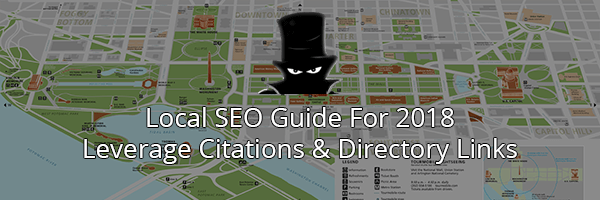
Consistent, relevant business citations and directories are another important part that we’ll cover in this local SEO guide.
There are many SEO tools that can help you build citations for your business, but we suggest you start with a free analysis with the Moz Local Business Tool. You’ll get an idea on how you appear on existing directories, and of course get additional directories and citations ideas for your business.
There’s also the WhiteSpark Tool (they also feature a citation building service), and of course Advice Local. A free alternative is to reverse engineer your competitor’s NAP+W information using Google and finding out where they’ve listed their information.
One extra advice we’d like to give you in our local SEO guide is to be creative. This applies to anything in life, really, but when it comes to local SEO marketing there are tons of tips and tricks to reverse search your competition while getting good backlinks opportunities. Don’t be afraid to try new things!
Local SEO guide: Reviews and Testimonials

Reviews and recommendations have a two-fold effect: they help your rankings for certain search terms and they impact your potential customer’s purchasing decisions.
This is why we recommend on our local SEO guide to funnel (whenever possible) your reviews and recommendations mainly to Google + or Yelp. You’ll want to go for numbers here, and definitely couple them with a powerful social signals pack. Google and Yelp are getting very good at spotting fake reviews, which is why you should always couple them with social media signals.
Think about it: whenever something goes viral you don’t just hear about it from reviews, you also get occasional comments on social media and even YouTube comments on relevant videos.
If your business is able to generate reviews in a more direct way (you incentivize clients to leave reviews when they talk to you directly) then that’s great. But you’ll want to diversify whenever possible and get reviews in large volumes
Businesses with tons of reviews have their CTR (click through rates) skyrocket over their competitors. They also see their leads and conversion rates rapidly increase.
Local SEO Guide: On-page SEO

We’re going to quickly go over some notable on page SEO factors, but we HIGHLY RECOMMEND you check the how to buy affordable SEO services small business article for in-depth information.
By the way, we also wrote an article on SEO strategies for affiliate marketing that details some On page and Backlink building strategies and resources you can use alongside our local SEO guide.
Last but not least, our Local SEO guide recommends some basic SEO optimization, especially at the early ages of positioning your business. This includes:
- H1,H2,H3 Tags optimized around your keywords
- Meta descriptions
- A Contact Us page with your detailed NAP information
- Your NAP information on your website’s footer
- Extensive use of Schema.org formats for local businesses
- org review formats for additional reviews featured on your site
- Individual pages for each service and product optimized around keywords and rich in Schema formats.
Again, we highly recommend you check our other articles for specific instructions on how to do this.
Local SEO Guide: Optimizing Social Media Profiles

So you’ve successfully set up your Google My Business dashboard, your Google + posts and reviews and your website is fully optimized.
Now it’s time to optimize your social media profile on platforms that could generate leads and connect you with your prospects:
Choosing the right social platforms can be difficult because it means you have to know which platforms your prospects use and whether or not you can successfully promote your business through those channels. The most popular platforms are Facebook, Twitter, LinkedIn and of course Instagram
The most important step towards optimizing your profiles is to use your NAP+W information (which should be the exact same across all platforms, directories and business citations) and regularly check up on them. The amount of information you can register varies from platform to platform, but having your business name, category, address, and phone is a must.
Working hours and photos are also great, but we recommend on our local SEO guide that you get testimonials and positive social signals together.
Remember, good businesses and products are discussed on different channels, and it’s important that Google picks up on this. It’ll help you rank for your target keywords considerably faster.
Local SEO guide: Private Blog Networks Usage
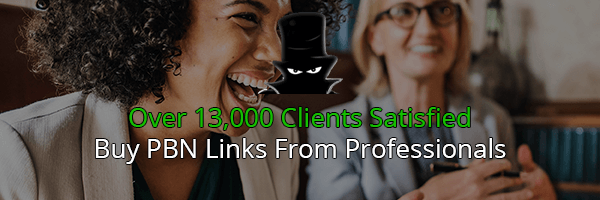
Another widely used tool for businesses is purchasing highly relevant, powerful PBN backlinks for their homepage mixed in with some guest posts and directory links that successfully diversify their anchor texts.
Business owners also buy PBN backlinks specifically for each of their individual products and service pages, so that they can further build context and rank for highly commercial keywords on each of their pages.
With Google’s introduction of Google My Business and the rise of Private Blog Networks links, reviews, and social media boosters, this year is looking to be an excellent year for local SEO marketing. So if you haven’t already, it’s highly recommended you start investing effort & time into it.
We hope you’ve enjoyed our local SEO guide. As always, feel free to contact us if you have any doubts.


